New Chromatography Columns and Accessories at Pittcon 2007: Part I
LCGC North America
This month's installment of "Column Watch" is the first of a two-part series in which Ron Majors examines the trends and highlights in columns and consumables at Pittcon 2007.
Pittcon 2007 — the 58th Pittsburgh Conference on Analytical Chemistry and Applied Spectroscopy — returned to the massive McCormick Place in Chicago, Illinois, on February 25–March 2, 2007. This year's event hosted more than 1000 instrument manufacturers and 1aboratory suppliers in more than 2500 booths. In addition to attending the exposition, the conferees listened to 1250 oral presentations, viewed more than 975 posters, checked numerous company seminar rooms, or attended one of 110 short courses.
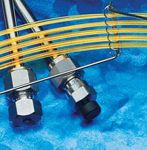
Undoubtedly, Pittcon still remains the most important yearly international analytical exhibition where companies introduce their latest instruments, instrument accessories, columns, sample preparation products, and other consumable products. Because many past attendees have purchased one or more new products within three months after attending the show, most exhibitors attempt to maximize their booth traffic to meet as many potential customers as possible.

Ronald E. Majors
The purpose of this report is to provide information about many of the new separation consumables and accessory products that were displayed at Pittcon 2007. In some cases, products that were introduced during 2006 but after Pittcon 2006 (1,2) might be included for reasons of completeness. The information is based upon manufacturers' responses to a questionnaire mailed in December 2006. Because of space limitations and the fact that some manufacturers did not respond to the questionnaire, this report cannot be considered an exhaustive listing of all new products that were introduced in Chicago. However, over the years, these Pittcon summaries have provided a good source of information that would be difficult for one individual to gather during the four days of the exhibition. In addition, the products introduced have shown definite correlations to current research, development, and application activity in the separation sciences.
As in previous years, columns and other products recommended by their manufacturers primarily for biomolecule separations or sample preparation are denoted in the tables with the designation BIO. Some of these products can be used for general high performance liquid chromatography (HPLC) separations as well, but their main emphasis is for biological samples. I will cite specific information about bioapplications where appropriate. Because the sub-2-μm HPLC columns are still quite new and require special care in their use, I have classified them as specialty columns or in a new series if an entire family was introduced at Pittcon.
In this month's coverage, I will describe new introductions in the areas of reversed-phase, normal- and bonded-phase, ion-exchange and ion, size-exclusion (SEC), large-and preparative-scale, and specialty chromatography columns. Next month, I will look at gas chromatography (GC) products, sample preparation products, and hardware, accessories and kits for chromatography and sample preparation.
Trends and Highlights
General: This year, I observed that there was a continued trend in high-throughput techniques, especially in the HPLC and sample preparation areas. In HPLC, there was an increase in the number of short and long, sub-2-μm columns and ultrahigh-pressure products, while in sample preparation, there were many products for solid-phase extraction (SPE) automation. Still, a large number of products were introduced for the separation, sample preparation, and for LC–mass spectrometry (MS) measurement of proteins — still the hottest area in chromatographic research and applications. Many application-specific columns for HPLC and GC were noted. A considerable number of new accessories in HPLC/ion chromatography areas were introduced.
HPLC columns: Reversed-phase HPLC maintains its dominance, and a significant number of regular reversed-phase and specialty reversed-phase columns were introduced. Particles are getting smaller (down to 1.5 μm), some with new designs, and columns are getting shorter; these columns allow separation speeds unheard of a decade ago. With the advent of new higher pressure instrumentation, new columns, column hardware, and fittings, and more rugged column packings are being introduced. Columns for proteins and peptides comprised about half of the specialty column offerings. Columns for the direct injection of drugs in biological fluids, more high-efficiency polymeric columns, and packings with reduced tailing for basic compounds were among the highlights at this year's Pittcon.
GC and SFC: GC columns this year were highlighted with higher temperature limits and lower bleed, and specialty columns were introduced for pharmaceutical, food–beverage, and flavor–fragrance analysis. A porous layer open tubular (PLOT) column for oxygenate analysis, such as methyl-tert-butyl ether in gasoline, was introduced. Supercritical fluid chromatography (SFC) is receiving more attention, especially in the preparative mode, and new packed columns for SFC were brought to market.
Sample preparation: Products for the preparation of tiny amounts of samples in the microliter and submicroliter range were quite prevalent. With a continuing trend, polymeric SPE phases represented about half of the products seen this year. Formats ranged from 96-well plates for method development, protein precipitation, and immobilized liquid extraction to SPE pipette tips to disks and cartridges to a new "in-syringe" SPE technique. More molecular-imprinted polymer (MIP) SPE products were introduced. Products for the depletion of high abundance proteins and phosphorylated peptides from serum, selective phases for environmental contaminants, a special chiral product for rapid enantiomeric separation, and phases for the direct injection of biological fluids were noted. Two manufacturers introduced a new technique called dispersive SPE.
Accessories: Thirty new accessories for LC, ion chromatography, GC, and sample preparation were noted. HPLC had a large number of accessories such as fittings, in-line filters, small internal-diameter tubing, injection valves, many suited for the newer high-efficiency and high-pressure columns on the market. Ion chromatography saw new suppressor designs and a carbon dioxide removal system. Software for peak tracking, column comparison, and e-learning were introduced. GC accessories included gas traps, gas generators, and preventive maintenance kits. A number of workstations for SPE, evaporation–concentration, liquid-phase sample preparation, and solvent recovery were introduced.
New Series of HPLC Columns and Packings
Each year manufacturers introduce entire new families of HPLC columns at Pittcon. For the sake of brevity, I have elected to cover those series here instead of listing each column under individual headings in the modes' tables. Table I covers those new families of HPLC columns and packings displayed at Pittcon 2007. In some cases, the series are extensions of existing products but cover additional phases while in other cases, the families are entirely new to the market.

Table I: New series of HPLC columns
The highlight of new families of products was the introduction of particle diameters smaller than the standard 3.0- or 3.5-μm packings and columns. Small particles packed into short columns give high throughput separations without loss of resolution or when packed into long columns give high resolution separation of more-complex mixtures, albeit at the higher operating pressure. If one peruses this year's introductions in new families (Table I) as well as in the ion-exchange, reversed-phase (Table II), and specialty columns (Table III), there are now more than 10 companies that have column products to address the emerging high-throughput market, with emphasis on sub-2-μm particles. These small particles are packed into columns that are as short as 20 mm and as long as 150 mm and have internal diameters as small as 0.075 mm and as large as 4.6 mm. For these small-particle columns, a wider variety of stationary phases are becoming available this year compared with Pittcon 2006 (1).
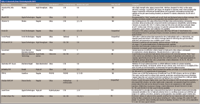
Table II: Reversed-phase chromatography (RPC)
One of the more interesting approaches to solve HPLC separation problems was shown by Bischoff Chromatography (Leonburg, Germany). In their phase-optimized liquid chromatography (POPLC) system, rather than keeping the stationary phase constant and changing the mobile phase conditions, the optimization of the stationary phase is the goal. Small segments of stationary phases with different selectivity are coupled together for the optimized column set for a particular separation. The retention time of each analyte is controlled by the use of the column with the best selectivity for that compound. In many cases in POPLC, no gradient is required. The key development is the design of new column hardware that allows coupling the different column segments without losing efficiency. With the basic kit containing five different stationary phases, 142,505 column combinations can be made. One of the benefits of this approach is that any column segment is exchangeable at any time. Therefore, if something fails with a column, only one segment and not the entire column must be replaced.

Table III: HPLC Specialty Columns
Reversed-Phase Chromatography
As usual, many new reversed-phase columns were introduced at Pittcon 2007 (see Table II). If one also adds all the reversed-phase columns covered in the new series (Table I), in specialty columns (Table III), and in the preparative chromatography section, one clearly can see the dominance of this operational mode. Silica-based bonded phase columns dominated the introductions again this year but a few hybrid, silica hydrid, zirconia, and polymeric columns were on the scene.

Table III: HPLC Specialty Columns continued
The most popular reversed-phase bonded phase always has been C18 (octadecylsilane) and this year proved it to be true once again with 27 C18 columns being introduced in all categories. However, this phase is not always the optimum for all separations and C8, C4 polar-embedded C18, hexyl-phenyl, phenyl, and cyanopropyl phases were made available by various suppliers to present different selectivity alternatives. In general, C8 has similar selectivity to the C18 phase but somewhat lower retention at the same mobile phase composition. The polar-embedded phases are particularly suited for the separation of basic compounds. These phases are useful for the separation of polar compounds in which a low percentage of organic modifier is required and where phase collapse (dewetting) can be a problem. Compared with the alkyl reversed-phase materials, the phenyl, diphenyl, and hexyl-phenyl phases each present a different selectivity by possible π–π interactions with the phenyl groups. The cyano (CN) phases offer a short chain reversed-phase packing that has some polar character by virtue of the cyano functionality. In addition to lower retention, selectivity can be quite different when compared with C8 and C18 phases. The cyano column also can be used for normal phase chromatographic separations by careful changeover from the aqueous-based mobile phase to entirely organic mobile phase.
Over the last several years, a number of longer chain alkyl phases up to C30 have been introduced. These long-chain phases provide a greater degree of shape selectivity than a typical C18 phase, long have proven to be superior for the separation of cis–trans carotenoid isomers, are resistant to phase collapse at low percentage of organic solvent in the mobile phase, and have high loadability. This year, another C30 phase joined the ranks.
A new particle design for reversed-phase was introduced by Advanced Materials Technology (Wilmington, Delaware) and is marketed by MacMod Analytical (Chadds Ford, Pennsylvania). The Halo is a dense solid-silica particle (2.7 μm) that has a thin 0.5-μm fused porous shell containing a bonded phase. Due to its limited diffusion path, this thin shell permits rapid solute mass transfer at high flow rates. This particle provides 50% more plates than a typical 3.5-μm particle when packed into the same column. Another new particle design is the Waters Acquity UPLC HSS T3 (Milford, Massachusetts), a high strength silica gel, which has an upper pressure limit of 1000 bar. Its selectivity is comparable to the company's Atlantis T3 C18 based upon a more conventional silica material with trifunctional bonding chemistry.
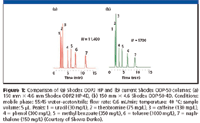
Figure 1
Tailing with basic compounds always has been a problem for silica-based reversed-phase materials, especially at intermediate pH values where any residual silanols are ionized. Agilent Technologies (Santa Clara, California) and Agela Technologies (Wilmington, Delaware) introduced columns that are specially modified to provide minimal tailing for basic compounds. The Agilent EclipsePlus C8 and C18 columns are silica-based while the Agela C18 is a hybrid polymer material.
Polymeric reversed-phase columns almost always show lower efficiency than silica-based columns of the same particle size. Showa Denko (Kawasaki, Japan) has introduced a hydrophilic polymer-coated silica that provides column efficiency nearly equivalent to most silica-based reversed-phase materials. Figure 1 compares the Shodex ODP2 HP column with the company's polymeric Shodex ODP-50 column both run under the same chromatographic conditions. The ODP2 HP column clearly shows better efficiency and slightly greater retention, especially for the more polar compounds. The hydrophilic polymer coating also retards proteins and, thus, biological fluids such as plasma can be injected directly without detrimental effects on the column. After 140 injections of bovine serum albumin onto the ODP2 HP column, the back pressure stayed constant, while with an equivalent C18 column, the backpressure increased 40% (3).
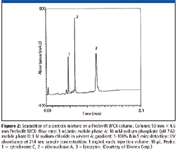
Figure 2
Ion-Exchange and Ion Chromatography
Besides the ion exchange specialty columns shown in Table III, four companies, Dionex (Sunnyvale, California), Sepax Technologies (Newark, Delaware), Metrohm (Herisau, Switzerland), and OraChrom (Woburn, Massachusetts) introduced new ion-exchange columns. All of these columns were based upon polymeric packings; in general, silica gel-based packings do not seem to stand up to the rigorous mobile phase conditions often used in ion-exchange separations.
The Dionex ProSwift columns consisted of two monolithic stationary phases, a quaternary amine for anion-exchange chromatography, and carboxylic acid functionality for weak cation-exchange capability. These columns are recommended for the rapid, high-resolution separation of large biomolecules. They also can be used for the desalting and preconcentration of protein samples. The monolith columns show low operating pressure at high flow rates. The columns are available with PEEK hardware in capillary, microbore, and analytical column dimensions. Figure 2 illustrates the separation of three proteins on a short ProSwift WCX (weak cation exchange) column. Gradient ion exchange always has been a favored technique for protein separations, and this monolith column provides a rapid separation (just over 4 min) with excellent resolution, including some minor impurities. Monoliths can be run at a high flow rate without generating much backpressure.

Figure 3
Dionex also extended its IonPac line of stationary phases with the introduction of the IonPac AS17-C 10.5-μm polymeric anion-exchange columns with alkanol quaternary ammonium functionality and pH 0–14 stability. These columns are designed for the rapid separation of common inorganic anions in high purity water matrices. Guard columns are available for all of the previously mentioned Dionex columns.
The Metrohm Metrosep C3-250 IC column is a cation exchanger based upon a polyalcohol material. It is recommended for the ion chromatography separation of mono- and divalent cations but also has found use in the separation of transition metal cations. The 250 mm × 4.6 mm column is constructed of PEEK and shows 42,000 plates/m for sodium and 31,000 plates/m for barium. Compared with other columns, it shows an improved separation of ammonium and sodium.
OraChrom's Styros SWAX phase is a shielded weak anion exchanger simulated monolith based upon polystyrene–divinylbenzene (PS-DVB) media. With OraChrom's gigaporous structure very large, multicharged oligonucleotides (greater than 50 bases) can be separated under low salt conditions with high yield. These stationary phases are hard gels that have higher mechanical and chemical stability than the soft gels used for similar separations. Thus, they can be used at higher flows for faster separation times. This shielded weak anion exchanger is an alternative to reversed-phase chromatography that is used currently for oligonucleotide separations.
The Sepax Proteomix ion-exchange offerings are based upon very highly crosslinked (80%) nonporous PS-DVB spherical resins with particle diameters of 1.7 μm. These columns are recommended for the ultrahigh-pressure and high-speed LC of proteins, peptides, nucleic acids, oligonucleotides, carbohydrates, and nanomaterials. Four chemistries, two cation exchangers (sulfonic strong cation and carboxyl weak cation), and two anion exchangers (quaternary ammonium strong anion and tertiary diethylamine weak anion) are available. In terms of standard column dimensions, microbore (2.1 mm i.d.) and conventional (3.0 and 4.6 mm i.d.) are available in 50-mm lengths with stainless steel or PEEK construction. Custom columns with 0.3–10 mm internal diameters and 20–250 mm lengths are available. The columns have a pH range of 2–12 and a pressure rating of 10,000 psi.
Size-Exclusion Chromatography
Each year, only a few new SEC columns are introduced at Pittcon. This year a total of six phases were introduced, all for aqueous SEC. Four were introduced by Sepax Technologies (Newark, Delaware), one by Polymer Laboratories (Amherst, Massachusetts), now part of Varian (Palo Alto, California), and one by Showa Denko (New York, New York). The Sepax offerings, called the SRT line, are designed for the SEC separation of biological materials, water-soluble polymers, nanoparticles, and bacteria. The columns are packed with spherical silica particles of 5-μm diameter with 150-, 300-, 500-, and 1000-Å pore sizes. The particles have a proprietary hydrophilic, neutral, 1-nm thick stationary phase that provides the aqueous compatibility. Standard column dimensions are 300 mm × 4.6 and 7.8 mm but custom columns are available in a variety of internal diameters from 0.1 to 50 mm and lengths ranging from 20 to 300 mm. Guard columns also are available. These high-capacity columns can be used with salt concentrations ranging from 10 mM to 2.0 M.
Polymer Labs/Varian introduced the PL Aquagel-OH Mixed C SEC column, which is based upon a hydrophilic macroporous crosslinked copolymer. It is recommended for the high-resolution separation of intermediate molecular weight water-soluble polymers. The 8-μm material is provided in column dimensions of 50 and 300 mm × 7.5 mm.
Showa Denko's Shodex KW400 series is a polymer-coated silica gel medium. The columns are packed with 3- or 5-μm particles (depending upon exclusion limits) and have the dimensions of 300 mm × 4.6 mm. The smaller particle sizes provide 50% more plates than the existing Shodex KW800 series. The columns are recommended for the high resolution, high recovery separation of proteins. There are three columns with exclusion limits of 150,000, 600,000, 1 × 106 , and 2 × 107 . A 10 mm × 4.6 mm guard column is provided. The KW800 series provides larger diameter columns for preparative purposes.
Specialty HPLC Columns
Specialty columns are HPLC columns that have been developed for specific separations that are difficult to achieve on a standard column. However, sometimes manufacturers will use a standard column but test it specifically for a certain class or compounds and provide a recommended set of chromatographic conditions. In some cases, the specialty column comes as part of a "total solution" kit with reagents, standards and method. Most specialty columns will be delivered with a test chromatogram from an analysis performed at the factory before shipment and some are guaranteed. Table III shows the 25 specialty columns that were presented at Pittcon 2007. Silica gel-based columns were still a majority but polymer-based columns were a close second followed by hybrid and zirconia specialty columns. Several more sub-2-μm high-throughput columns also show up in the specialty category.
In addition to products covered in Table I and in the ion-exchange category, the largest categories of specialty columns were those designated for the separation of biomolecules (50% of total), mainly for proteins, peptides, and amino acids. Products for protein separation ranged from monolith materials to wide-pore ion-exchange, reversed-phase, hydrophobic interaction, and affinity columns to bulk reversed-phase packings for those who wish to pack their own columns. Other specialty application categories were for columns for enantiomeric separations, carbohydrates, oligonucleotides, aldehydes, and ketones and organic acids.
The analysis of carbohydrates is important in the biochemical and food markets. Although there are silica-based columns useful for the separation of simple saccharides, polymeric columns seem to be favored for separation of more complex carbohydrate mixtures. Often the separations are accomplished on metal-loaded strong cation exchange resins. An example of an application of a specialty carbohydrate column is depicted in Figure 3. The Carbomix Ca-NP5 column is a 5% crosslinked PS-DVB resin having sulfonic acid groups in which the H+ has been replaced with Ca++ . The separation of carbohydrates in beer is accomplished with a pure water eluent. This transparent solvent has no UV absorbance so a wavelength of 192 nm was used. It is speculated that the mechanism of this separation can involve size- or ion-exclusion and hydrophilic interactions because carbohydrates would not undergo ionic interactions in water.

Companies Listed in This Column
Among the more interesting biocolumns were those specific for phosphorylated peptides based upon their interaction with titania and zirconia (Zirchrom), IMAC for his-tagged proteins (BioRad), C4 columns for hydrophobic proteins (GE Healthcare and OraChrom), and the oligonculeotide separation kit (Waters).
The immobilized cellulose and derivatized cellulose columns from Chiral Technologies (Exton, Pennsylvania) and Eka Nobel (Eka Chemicals, Bohus, Sweden) provide a more universal chiral technology that can be used in normal-phase, reversed-phase, and polar-organic separation modes.
Mixed-mode columns were introduced by Dionex and SIELC Technologies (Prospect Heights, Illinois). Such columns usually consist of an alkyl group for reversed-phase interactions and an ion-exchange functionality for ionic interactions. In addition to being useful for single-mode separations, the dual functionality provides additional selectivity for compounds containing ionic or ionizable groups. Among compounds that appear to have better separation characteristics on mixed-mode columns are organic acids, quaternary amines, and drugs of abuse. Other possible mechanisms of interaction with these mixed-mode columns include ion exclusion and hydrophilic interaction.
Preparative Chromatography
Four new column products and one column-packing device, specifically for preparative chromatography were introduced at this year's Pittcon. Guard columns are especially important in preparative chromatography because large volumes of unfriendly matrices are sometimes injected and the preparative columns that they are designed to protect are often very costly. Isolation Technologies' Iso-Prep Guard column (10-mm length × 21.2-mm internal diameter) offers column protection for adsorptive samples when packed with the same packing as the preparative column itself. A sample distribution system is incorporated to ensure that the sample is spread over the surface of the guard column so that the optimum mass of packing is used for the preparative separation. It can be used for preparative columns of 20–50-mm internal diameter, and its 10-mm length provides a low pressure drop even at flow rates in excess of 50 mL/min. The inlet frit also acts as a particulate trap.
Daiso U.S. (Santa Clara, California) has been a supplier of silica-based packings materials and now preparative columns. The company's high-pressure preparative columns have a unique flow distribution system that provides uniform flow across the top of the media bed at the column inlet and outlet yielding analytical level performance in a preparative-scale column. Figure 4 shows the column design highlights. The flanged column is designed with two heavy-duty endplates that are engineered to promote homogeneous flow across the boundaries of the media bed. These endplates have a central blocked inlet and a series of radial and circular slots of variable depth to maximize the equal flow distribution across a wide range. This design without threads gives the reusable column hardware an extended life.
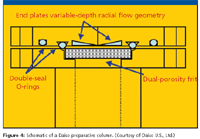
Figure 4
Varian (Palo Alto, California) introduced the Pursuit XRs Prep columns specifically designed for benchtop preparative LC applications. The packing materials of 5- and 10-μm particle sizes provide high resolution, and the high-density bonding chemistry on 100-å silica gel gives high mass loading. So far, silica and C18 phases are available.
Last year, Phenomenex (Torrance, California) introduced the AXIA column packing and hardware system, which is designed to minimize column failure due to bed voiding by using hydraulic piston compression to keep pressure on the packed bed during use. The initial system was developed for 21.2- and 30-mm i.d. columns. It has now been expanded to produce larger 50-mm diameter columns allowing at least three times the load of the 21.2-mm columns. Packings of 4-, 5-, and 10-μm particle diameters in C18, hexyl-phenyl, and other Phenomenex phases are available in 50 and 100 mm × 50 mm sizes.
Finally, a preparative HPLC floor-standing column packer called the PowerPac was introduced by Biotech-Sweden (Onsala, Sweden). This system uses dual axial compression to ensure a homogeneous bed and to minimize column voids. The packer can be maintained at a user-selected temperature between -10 °C and 70 °C by using an external heating and cooling system. Stainless steel columns with bed lengths up to 350 mm can withstand pressures as high as 200 bar.
Acknowledgment
I would like to thank the manufacturers and distributors who kindly furnished the requested information in advance of Pittcon 2007, thus allowing a timely report on new product introductions. For those manufacturers who would like to be considered for inclusion into Pittcon 2008 coverage, please send the name of the primary company contact, the mailing address, FAX and E-mail numbers to Patrick Kempf, Managing Editor, LCGC North America, c/o Advanstar Communications, 485 Rte. 1 South, Bldg. F, Iselin, NJ 08830, Attn.: Pittcon '08 "Column Watch."
Ronald E. Majors
"Column Watch" Editor Ronald E. Majors is a senior chemist, Agilent Technologies, Life Sciences and Chemical Analysis, Columns and Supplies Division, Wilmington, Delaware, and is a member of LCGC's editorial advisory board. Direct correspondence about this column to "Sample Prep Perspectives," LCGC, Woodbridge Corporate Plaza, 485 Route 1 South, Building F, First Floor, Iselin, NJ 08830, e-mail lcgcedit@lcgc-mag.com.
References
(1) R.E. Majors, LCGC 24(3), 248-266 (2006)
(2) R.E. Majors, LCGC 24(4), 356-373 (2006)
(3) Shodex Chromato News No. 30, Showa Denko, Kawasaki, Japan, September 1, 2006.
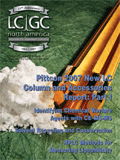
Study Explores Thin-Film Extraction of Biogenic Amines via HPLC-MS/MS
March 27th 2025Scientists from Tabriz University and the University of Tabriz explored cellulose acetate-UiO-66-COOH as an affordable coating sorbent for thin film extraction of biogenic amines from cheese and alcohol-free beverages using HPLC-MS/MS.
Multi-Step Preparative LC–MS Workflow for Peptide Purification
March 21st 2025This article introduces a multi-step preparative purification workflow for synthetic peptides using liquid chromatography–mass spectrometry (LC–MS). The process involves optimizing separation conditions, scaling-up, fractionating, and confirming purity and recovery, using a single LC–MS system. High purity and recovery rates for synthetic peptides such as parathormone (PTH) are achieved. The method allows efficient purification and accurate confirmation of peptide synthesis and is suitable for handling complex preparative purification tasks.













